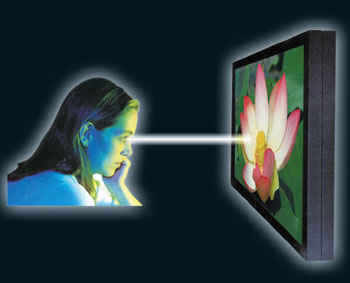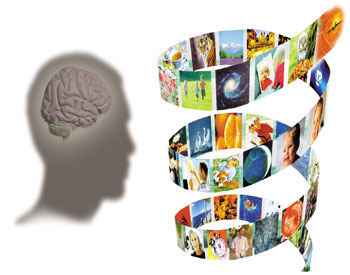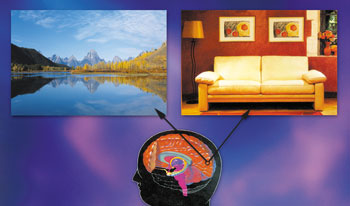The Reality of Matter (1/2)
 |
The concept of "the real nature of matter" is one liable to change one's outlook on life, and indeed, one's whole life, once its essence is known. This subject is directly related to the meaning of your life, your expectations from the future, your ideals, demands, plans, the concepts you esteem, and the material things you possess.
The subject matter of this chapter, "the reality of matter", is not a subject raised today for the first time. Throughout the history of humanity, many thinkers and scientists have discussed this concept. Right from the start, people have been divided into two groups on this issue; one group, known as materialists, based their philosophies and lives on the assumption of absolute existence of matter and lived by deceiving themselves. Another group acted sincerely, and being unafraid of thinking more profoundly, led their lives by grasping the essence of the "things" to which they were exposed and the deep meaning lying beyond them. However, advances in the science and technology of our age have finally ended this controversy and indisputably proven a self-evident fact that we can never encounter directly with the essence of matter.
The importance of the subject comes from its impact on man's whole life. Every person has a limited lifetime, and Allah tests them during this period. Each individual will subsequently be recompensed strictly according to the path he chose to follow, the manners and character he displayed in this world, his eternal life being shaped by what he has merited. This means that in his endless life, he will be requited for the life he has chosen in the world, and will never again have the chance to make amends for his mistakes.
From this viewpoint, it is easier to understand the value of people's lives on earth. Hence the importance of the subject tackled in this book. Since everyone has a short test time, and will be rewarded or punished for his deeds in his endless afterlife, then it surely follows that he must spend this period in the wisest way. If he fails to do that, his ultimate remorse will be of no avail.
The purpose of this book is to help man before he comes to a stage of an irreversible remorsee, on "that day" when man will go to Allah's Presence "all alone just as We created you at first." (Surat al-An'am: 94)
The real nature of matter is first addressed, therefore, from a scientific perspective. As we have earlier stated, the subjects described here are definitely not a matter of opinion or a philosophical idea, but facts proved in many areas of science. Moreover, this subject is not a complex, incomprehensible or difficult one, as is commonly supposed. Anyone who does not flinch from thinking and who sincerely reflects upon reality will easily come to a very important conclusion in terms of his own life, once he has grasped these facts.
What you will read now will perhaps become the key to many issues which you were hitherto unable to resolve or completely understand; you will have a fuller comprehension of crucial concepts in depth and live by acknowledging the meaning of life.
The Long Discussed Question: What is the Real Nature of Matter?
Those who contemplate their surroundings conscientiously and wisely realize that everything in the universe—both living and non-living—must have been created. So the question becomes, "Who is the Creator of all these things?"
It is evident that the Creation that reveals itself in every aspect of the universe cannot be an outgrowth of the universe itself. For example, no insect could have created itself, nor could the solar system have created or organized itself. Neither could plants, humans, bacteria, red-blood cells, nor butterflies have created themselves. As this book explains throughout, any possibility that all these could have originated "by chance" is unimaginable.
Therefore, we arrive at the following conclusion: Everything that we see has been created, but nothing we see can itself be a "creator." The Creator is different from—and superior to—all that we see, a Superior Power Who is invisible to our eyes, but Whose existence and attributes are revealed in everything that He creates.
This is where those who deny Allah's existence are led astray. They are conditioned not to believe in Allah's existence unless they see Him with their own eyes, forced to conceal the actuality of Creation manifested all throughout the universe, and to claim that the universe and all the living things it contains have not been created. In order to do so, they resort to falsehoods. Evolutionary theory is one key example of their lies and vain endeavors to this end.
The basic mistake of those who deny Allah is shared by many others who don't actually deny His existence, but have wrong perceptions of Him. These people, constituting the majority of society in some countries, do not deny Creation openly, but have superstitious beliefs about Allah, most believing that He is only "up in the sky." They tacitly and falsely imagine that Allah is off behind some very distant planet and only occasionally interferes with worldly affairs. Or perhaps He doesn't intervene at all: He created the universe, and then left it to itself, leaving humans to determine their fates for themselves. (Surely Allah is beyond that.)
Still others are aware of the fact that Allah is "everywhere," as revealed in the Qur'an, but cannot fully understand what this means. Superstitiously, they think that Allah surrounds all matter like radio waves or like an invisible, intangible gas. (Allah is certainly beyond that.)
However, this and other notions that cannot clarify "where" Allah is (and unwisely deny His apparent existence perhaps because of this) are all based on a common mistake: They hold a groundless prejudice that moves them to wrong opinions about Allah.
What is this prejudice? It concerns the existence and nature of matter. Some people have been so conditioned to the mistaken ideas about the true nature of matter that they may have never thought about it thoroughly. Modern science, however, demolishes this prejudice about the nature of matter and discloses a very important and imposing truth. In the following pages, we will explain this great reality pointed to in the Qur'an.
The World of Electrical Signals
 |
Stimulations coming from an object are converted into electrical signals and cause effects in the brain. When we "see", we in fact view the effects of these electrical signals on the mind. |
All the information we have about the world is conveyed to us by our five senses. Thus, the world we know consists of what our eyes see, our hands feel, our nose smells, our tongue tastes, and our ears hear. Many people never think that the external world can be other than what our senses present to us, since we've depended on those senses since the day we were born.
Yet modern research in many different fields of science points to a very different understanding, leading to serious doubt about the "outside" world that we perceive with our senses.
For this new understanding, the starting point is that everything we perceive as external is only a response formed by electrical signals in our brain. The information one has about the red of an apple, the hardness of wood—moreover, one's mother, father, family, and everything that one owns, one's house, job, and even the pages of this book—is comprised of electrical signals only. In other words, we can never know the true color of the apple in the outside world, nor the true structure of wood there, nor the real appearance of our parents and the ones we love. They all exist in the outside world as Allah's Creations, but we can only have direct experience of the copies in our brains for so long as we live.
To clarify, let's consider the five senses which provide us with all our information about the external world.
How Do We See, Hear, and Taste?
 |
All we see in our lives is formed in a part of our brain called the "center of vision" which occupies only a few cubic centimeters. The brain is insulated from light. Inside the skull is absolutely dark; and the brain itself has no contact with light that exists outside. |
The act of seeing occurs in a progressive fashion. Light (photons) traveling from the object passes through the lens in front of the eye, where the image is refracted and falls, upside down, onto the retina at the back of the eye. Here, visual stimuli are turned into electrical signals, in turn transmitted by neurons to a tiny spot in the rear of the brain known as the vision center. After a series of processes, these electrical signals in this brain center are perceived as an image. The act of seeing actually takes place at the posterior of the brain, in this tiny spot which is pitch dark, completely insulated from light.
Even though this process is largely understood, when we claim, "We see," in fact we are perceiving the effects of impulses reaching our eye, transformed into electrical signals, and induced in our brain. And so, when we say, "We see," actually we are observing electrical signals in our mind.
All the images we view in our lives are formed in our center of vision, which takes up only a few cubic centimeters in the brain's volume. The book you are now reading, as well as the boundless landscape you see when you gaze at the horizon, both occur in this tiny space. And keep in mind that, as noted before, the brain is insulated from light. Inside the skull is absolutely dark; and the brain itself has no contact with light that exists outside.
An example can illustrate this interesting paradox. Suppose we place a burning candle in front of you. You can sit across from it and watch this candle at length. During this time, however, your brain never has any direct contact with the candle's original light. Even while you perceive the candle's light, the inside of your brain is lightless. We all watch a bright, colorful world inside our pitch-dark brain.
R. L. Gregory explains the miraculous aspect of seeing, which is taken so very much for granted:
We are so familiar with seeing, that it takes a leap of imagination to realize that there are problems to be solved. But consider it. We are given tiny distorted upside-down images in the eyes, and we see separate solid objects in surrounding space. From the patterns of simulation on the retinas we perceive the world of objects, and this is nothing short of a miracle.1
The same applies to all our other senses. Sound, touch, taste and smell are all transmitted as electrical signals to the brain, where they are perceived in the relevant centers.
 |
The scent of a perfume, a flower, any delicious food, the sea, or other odors we like or dislike, we perceive entirely in our brain. |
The sense of hearing proceeds in the same manner. The auricle in the outer ear picks up available sounds and directs them to the middle ear; the middle ear transmits the sound vibrations to the inner ear by intensifying them; the inner ear translates these vibrations into electrical signals and sends them to the brain. Just as with the eye, the act of hearing takes place in the brain's hearing center. The brain is insulated from sound just as it is from light. Therefore, no matter how noisy it may be outside, it is completely silent inside the brain.
Nevertheless, the brain perceives sounds most precisely, so that a healthy person's ear hears everything without any atmospheric noise or interference. Your brain is insulated from sound, yet you listen to the symphonies of an orchestra, hear all the noises in a crowded auditorium, and perceive all sounds within a wide frequency, from the rustling of leaves to the roar of a jet plane. However, were a sensitive device to measure the sound level in your brain, it would show complete silence prevailing there.
Our perception of odor forms in a similar way. Volatile molecules, emitted by vanilla extract or a rose, reach receptors in the delicate hairs in the olfactory epithelium and become involved in an interaction that is transmitted to the brain as electrical signals and perceived as smell. Everything that you smell, be it pleasant or repugnant, is only your brain's perception of the interactions of volatile molecules transformed into electrical signals. The scent of a perfume, a flower, any delicious food, the sea, or other odors you like or dislike, you perceive entirely in your brain. The molecules themselves never reach there. Just as with sound and vision, what reaches your sensory centers is simply an assortment of electrical signals. In other words, all the sensations that, since you were born, you've assumed to belong to external objects are just electrical signals interpreted through your sense organs. You can never have direct experience of the true nature of a scent in the outside world.
 |
Rays of light coming from an object fall upside-down on the retina as seen in the above picture. Here, the image is converted into electrical signals and transmitted to the center of vision at the back of the brain. The center of vision is a very tiny place. Since the brain is insulated from light, it is impossible for light to reach the center of vision. This means that we view a vast world of light and depth in a tiny spot that is insulated from light. Even at the moment when we feel the light and heat of a fire, the inside of our brain is pitch dark and its temperature never changes. |
Similarly, at the front of your tongue, there are four different types of chemical receptors that enables you to perceive the tastes of salty, sweet, sour, and bitter. After a series of chemical processes, your taste receptors transform these perceptions into electrical signals and transmit them to the brain, which perceives these signals as flavors. The taste you get when you eat chocolate or a fruit that you like is your brain's interpretation of electrical signals. You can never reach the object outside; you can never see, smell or taste the chocolate itself. For instance, if the nerves between your tongue and your brain are cut, no further signals will reach your brain, and you will lose your sense of taste completely.
Here, we come across another fact: You can never be sure that how a food tastes to you is the same as how it tastes to anyone else; or that your perception of a voice is the same as what another's when he hears that same voice. Along the same lines, science writer Lincoln Barnett wrote that "no one can ever know whether his sensation of red or of Middle C is the same as another man's."2
Our sense of touch is no different. When we handle an object, all the information that helps us recognize it is transmitted to the brain by sensitive nerves on the skin. The feeling of touch is formed in our brain. Contrary to conventional wisdom, we perceive sensations of touch not at our fingertips or on our skin, but in our brain's tactile center. As a result of the brain's assessment of electrical stimulations coming to it from the skin, we feel different sensations pertaining to objects, such as hardness or softness, heat or cold. From these stimulations, we derive all details that help us recognize an object. Concerning this important fact, consider the thoughts of B. Russell and L. J. J. Wittgenstein, two famous philosophers:
For instance, whether a lemon truly exists or not and how it came to exist cannot be questioned and investigated. A lemon consists merely of a taste sensed by the tongue, an odor sensed by the nose, a color and shape sensed by the eye; and only these features of it can be subject to examination and assessment. Science can never know the physical world.3
It is impossible for us to reach the original of the physical world outside our brain. All objects we're in contact with are actually collection of perceptions such as sight, hearing, and touch. Throughout our lives, by processing the data in the sensory centers, our brain confronts not the "originals" of the matter existing outside us, but rather copies formed inside our brain. We can never know what the original forms of these copies are like.
The "External World" Inside Our Brain
 |
All we see in our lives is formed in a part of our brain called the "center of vision" which lies at the back of our brain, and occupies only a few cubic centimeters. Both the image of a small room and the boundless landscape you see when you gaze at the horizon fit into this tiny space. Therefore, we see objects not in their actual sizes existing outside, but in the sizes perceived by our brain. |
As a result of these physical facts, we come to the following indisputable conclusion: We can never have direct experience of any of the things we see, touch, hear, and name "matter," "the world" or "the universe." We only know their copies in our brain and can never reach the original of the matter outside our brain. We merely taste, hear and see an image of the external world formed in our brain. In fact, someone eating an apple confronts not the actual fruit, but its perceptions in the brain. What that person considers to be an apple actually consists of his brain's perception of the electrical information concerning the fruit's shape, taste, smell, and texture. If the optic nerve to the brain were suddenly severed, the image of the fruit would instantly disappear. Any disconnection in the olfactory nerve traveling from receptors in the nose to the brain would interrupt the sense of smell completely. Simply put, that apple is nothing but the interpretation of electrical signals by the brain.
Also consider the sense of distance. The empty space between you and this page is only a sense of emptiness formed in your brain. Objects that appear distant in your view also exist in the brain. For instance, someone watching the stars at night assumes that they are millions of light-years away, yet the stars are within himself, in his vision center. While you read these lines, actually you are not inside the room you assume you're in; on the contrary, the room is inside you. Perceiving your body makes you think that you're inside it. However, you must remember that you have never seen your original body, either; you have always seen a copy of it formed inside your brain.
The same applies to all other perceptions. When you believe you're hearing the sound of the television in the next room, for instance, actually you are experiencing those sounds inside your brain. The noises you think are coming from meters away and the conversation of the person right beside you—both are perceived in the auditory center in your brain, only a few cubic centimeters in size. Apart from this center of perception, no concepts such as right, left, front or behind exist. That is, sound does not come to you from the right, from the left, or from above; there is no direction from which sound "really" comes.
Similarly, none of the smells you perceive reach you from any distance away. You suppose that the scents perceived in your center of smell are the real ones of outside objects. However, just as the image of a rose exists in your visual center, so its scent is located in your olfactory center. You can never have direct contact with the original sight or smell of that rose that exists outside.
To us, the "external world" is a collection of the electrical signals reaching our brains simultaneously. Our brains process these signals, and some people live without recognizing how mistaken they are in assuming that these are the actual, original versions of matter existing in the "external world." They are misled, because by means of our senses, we can never reach the matter itself.
Again, our brain interprets and attributes meanings to the signals related to the "external world" of which people imagine they are in contact with the original that exists outside. Consider the sense of hearing, for example. In fact, our brain interprets and transforms sound waves reaching our ear into symphonies. That is to say, we know music as interpreted by our brain, not the original music that exists outside. In the same manner, when we see colors, different wavelengths of light are all that reaches our eyes, and our brain transforms these wavelengths into colors. The colors in the "external world" are unknown to us. We can never have direct experience of the true red of an apple, the true blue of the sky or the true green of trees. The external world depends entirely on the perceiver.
Even the slightest defect in the eye's retina can cause color blindness. Some people perceive blue as green, others red as blue, and still others see all colors as different tones of gray. At this point, it no longer matters whether the outside object is colored or not.
The World of Senses Can Occur Without Outside World's Existence
One factor which reveals that everything we see and experience exists in our brain and that we can never know the original of the matter that exists outside is that we do not need an outside world for senses to occur in the brain. Many technological developments such as simulators and also dreams are the most important evidences of this truth.
Science writer, Rita Carter, states in her book, Mapping the Mind, that "there's no need for eyes to see" and describes at length an experiment carried out by scientists. In the experiment, blind patients were fitted with a device that transformed video pictures into vibrating pulses. A camera mounted next to the subjects' eyes spread the pulses over their backs so they had continuous sensory input from the visual world. The patients started to behave as if they could really see, after a while. For example, there was a zoom lens in one of the devices so as to move closer the image. When the zoom is operated without informing the patient beforehand, the patient had an urge to protect himself with two arms because the image on the subject's back expanded suddenly as though the world was looming in.4
As it is seen from this experiment, we can form sensations even when they are not caused by material equivalents in the outside world. All stimuli can be created artificially.
"The world of senses" that we experience in dreams
A person can experience all senses vividly without the presence of the outside world. The most obvious example of this is dreams. A person lies on his bed with closed eyes while dreaming. However, in spite of this, that person senses many things which he or she experiences in real life, and experiences them so realistically that the dreams are indistinguishable from the real life experience. Everyone who reads this book will often bear witness to this truth in their own dreams. For example, a person lying down alone on a bed in a calm and quiet atmosphere at night might, in his dream, see himself in danger in a very crowded place. He could experience the event as if it were real, fleeing from danger in desperation and hiding behind a wall. Moreover, the images in his dreams are so realistic that he feels fear and panic as if he really was in danger. He has his heart in his mouth with every noise, is shaken with fear, his heart beats fast, he sweats and demonstrates the other physical affects that the human body undergoes in a dangerous situation.
A person who falls from a high place in his dream feels it with all his body, even though he is lying in bed without moving. Alternatively, one might see oneself slipping into a puddle, getting soaked and feeling cold because of a cold wind. However, in such a case, there is neither a puddle, nor is there wind. Furthermore, despite sleeping in a very hot room, one experiences the wetness and the cold, as if one were awake.
Someone who believes he is dealing with the original of the material world in his dream can be very sure of himself. He can put his hand on his friend's shoulder when the friend tells him that "it isn't possible to deal with the original of the world", and then ask "Don't you feel my hand on your shoulder? If so, how can you say that you don't see the original matter? What makes you think this way? Let's take a trip up the Bosphorus; we can have a chat about it and you'll explain to me why you believe this." The dream that he sees in his deep sleep is so clear that he turns on the engine with pleasure and accelerates slowly, almost jumping the car by pressing the pedal suddenly. While going on the road, trees and road lines seem solid because of the speed. In addition, he breathes clean Bosphorus air. But suppose he is woken up by his ringing alarm clock just when he's getting ready to tell his friend that he's seeing the original of matter. Wouldn't he object in the same manner regardless of whether he was asleep or awake?
The World in Dreams

For you, reality is all that can be touched with the hand and seen with the eye. In your dreams you can also "touch with your hand and see with your eye", but in reality, then you have neither hand nor eye, nor is there anything that can be touched or seen. In your dreams, there is no material reality that makes these things happen except your brain. You are simply being deceived

What is it that separates real life and dreams from one another? Ultimately, both forms of living are brought into being within the brain. If we are able to live easily in an unreal world during our dreams, a similar state of affairs can equally be true for the world we live in while awake. When we wake up from a dream, there is no logical reason not to think that we have entered a longer dream called "real life". The reason dreams are considered fancies and the world 'real' is only a product of habits and prejudices. This shows that you may well be awoken from the life on earth, which you think you are living right now, just as you are awoken from a dream.
When people wake up they understand that what they've seen until that moment is a dream. But for some reason they are not suspicious of the nature of the life (what they call "real") that starts with a "waking" image. However, the way we perceive images in "real life" is exactly the same as the way we perceive our dreams. We see both of them in the mind. We cannot understand they are images until we are woken up. Only then do we say "what I have just seen was a dream." So, how can we prove that what we see at any given moment is not a dream? We could be assuming that the moment in which we are living is real just because we haven't yet woken up. It is possible that we will discover this fact when we are woken up from this "waking dream" which takes longer than dreams we see everyday. We do not have any evidence that proves otherwise.
Many Islamic scholars have also proclaimed that the life around us is only a dream, and that only when we are awakened from that dream with "a big awakening," will people be able to understand that they live in a dreamlike world. A great Islamic scholar, Muhyiddin Ibn al-'Arabi, referred to as Sheikh Akbar (the greatest Sheikh) due to his superior knowledge, likens the world to our dreams by quoting a saying of the Prophet Muhammad (may Allah bless him and grant him peace):
The Prophet Muhammad [may Allah bless him and grant him peace] said that, "people are asleep and wake up when they die." This is to say that the objects seen in the world when alive are similar to those seen when asleep while dreaming...5
In a verse of the Qur'an, people are told to say on the Day ofJudgment when they are resurrected from the dead:
They will say, "Alas for us! Who has raised us from our resting-place? This is what the All-Merciful promised us. The Messengers were telling the truth." (Surah Ya Sin: 52)
As demonstrated in the verse, people wake up on the Day of Judgment as if waking from a dream. Like someone woken from the middle of a dream in deep sleep, such people will similarly ask who has woken them up. As Allah reveals in the verse, the world around us is like a dream and everybody will be woken up from this dream, and will begin to see images of the afterlife, which is the real life.
This World is a Dream Place. '
'People are Asleep, and Wake with Death.''

PRESENTER: There is a hadith that reads "The worst of you is he who loves the world."
ADNAN OKTAR: No, if they knew what this world was, they would not love it or be so attached to it. They have no ideas what it is. For example, I am picking this cup up; it is perfectly clear. It can be seen 3-dimensionally. It does not seem to be an image. It also appears to be at a distance from me, such is the high quality image that forms. And the sense of touch also arises.

That is also in my brain. But it is as if I am touching it at a distance. In other words, since the quality of sensation is 3-D, it really gives me the impression I am touching it at a distance. And it has a taste. Lime. It is sweet, and has a scent. Now let someone who does not believe come here. But these things all form in my brain. Because of this image and the 3-D quality of the senses; all five senses are such high quality. Allah creates sensations to a very high quality. They are flawless, immaculate and very sharp. But they are sharper in the Hereafter, of course....
CIHAT GUNDOGDU: As you have said, the hadiths say "People are asleep, and wake with death." Insha' Allah.
ADNAN OKTAR: "People are asleep, and they wake with death." They wake, and again go to another kind of asleep, of course. This is very clear, it totally clarifies the issue. "People are asleep, and they wake with death." That is the essence of what I am talking about. And our Prophet (may Allah bless him and grant him peace) says it. In the same way is illogical to cry over or be saddened by a dream, so it is illogical to cry over or be saddened by anything in this world. (Mr. Adnan Oktar's live interview on HarunYahya.tv, 4 March 2010)
Footnotes
1. R. L. Gregory, Eye and Brain: The Psychology of Seeing, Oxford University Press Inc. New York, 1990, p. 9
2. Lincoln Barnett, The Universe and Dr.Einstein, William Sloane Associate, New York, 1948, p.20
3. Orhan Hancerlioğlu, Dusunce Tarihi (The History of Thought), Istanbul: Remzi Bookstore, 6.ed., September 1995, p.447
4. Rita Carter, Mapping the Mind, p. 113
5. Muhyiddin Ibn al-'Arabi, Fusus al-Hikam, p. 220
